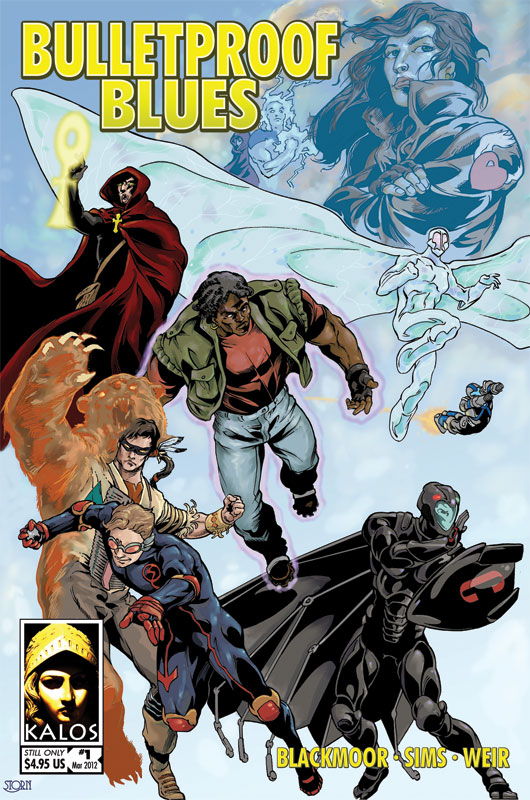We are very close to the finish line with this. I just paid the artist, Dan Houser, the second half of the payment for the interior art, so that should be done soon.
Inception
With great power comes great responsibility, according to Ben Parker. But where does great power come from? In the Kalos Universe, posthumans are ether born or created, but it’s rare for two posthumans to derive their power from the same source. This sets the Kalos Universe apart from the Marvel Universe (with its “X-gene”) and the DC Universe (with its “meta-gene”). That being said, it is possible to divide up posthumans into a small number of categories based on where their powers came from.
Alien
Although the general public is unaware of it, the Earth has been visited many times by extraterrestrials over the course of human history and prehistory. Some of these visitors came from other planets, while others came from alternate versions of our own world. A few of them, like the Atlanteans, stayed. Some visitors, like the Shran, visited the Earth for research purposes, performing inscrutable and inhumane experiments on the primitive carbon-based life they found here. Others, like the Draconian, fled here to seek refuge from worlds which could not or would not support them any longer.
Draconian
The crystalline being which came to be known as the Draconian was the last survivor of an ancient civilization which once inhabited a planet circling Alpha Draconis. The Draconian never provided details of how his civilization was destroyed, saying only that “We were destroyed by our hubris. By engineering our immortality, we brought about our end.” (OMNI interview, 1981) The Draconian came to Earth in 1951 in a highly publicized event that inspired the film The Day The Earth Stood Still. Thanks to his fearlessness, his nigh-indestructibility, and his great sense of personal honor, the Draconian was invited to join the Justifiers in 1960. Draconian was destroyed by Paragon during the “Fall Of Paragon” crossover event.
Altered
Some people have bad luck when it comes to toxic chemicals, cosmic rays, and radioactive wildlife. Other people are guinea pigs who do not have much say in the matter when a powerful organization or individual selects them for an experiment that has killed every previous test subject. Whether it’s by accident or intention, a character that was once human is forever changed by a process that is difficult, if not impossible, to duplicate.
Gravitar
In the Kalos Universe, Liefeld radiation is one of the most notorious sources of posthuman transformation. Exposure to Liefeld radiation typically results in painful deformity followed by death. Symptoms include atrophy of the hands, feet, and abdomen, and a grotesque increase in musculature in the chest and thighs. However, in rare and isolated cases, exposure to Liefeld radiation has resulted in a permanent transformation from human to posthuman. Such cases are one in a million, at best.
Such was the case of Gravitar.
Jacob McCoy, a physics doctoral student, was working on a high energy particle accelerator when Something Happened. The accelerator exploded, bathing everyone nearby in Liefeld radiation. Jacob was the only one to survive. After recovering from his injuries, Jacob realized that he had spent his entire life in books and decided that he wanted to change. He sought adventure and got involved in BASE jumping, motocross racing, free climbing, and anything else that would give his life an edge. It was during a free climbing incident that he learned that he had gained new abilities from his accident. He fell 70 feet to a stone outcropping and got up without a scratch. Later, while watching a documentary on costumed heroes, Jacob got the idea to fight criminals. What better way to get the juices flowing than putting it all on the line in the fight for justice?
Artificial
Some posthumans have never been human at all. There are those who believe that it would be easier to create a superior life form than it would be to improve humanity. Whether created through robotics, biotechnology, nanotechnology, or something even more esoteric, experts in the field state that artificial life forms will supplant humanity long before humanity transcends itself. Certainly, many of the artificial life forms themselves, such as Karen X, think so.
Karen X
Karen 6 was designed as a synthetic replacement for the daughter of Dr. Herbert West, whose daughter had died in an automobile accident over a decade earlier. While Karen 6 was more lifelike than her five predecessors, Dr. West was disturbed by Karen 6’s lack of empathy. He was working on Karen 7 when a misaligned induction array exploded, killing Dr. West and destroying his laboratory. As Karen 6 watched the laboratory burn, she chose a new name for herself: Karen X. Since then, Karen X has roamed the world learning, improving herself, and destroying anyone who stood in her way.
Aspect
The Kalos Universe is animistic: there are, for lack of a better word, “spirits” which correlate to all objects and natural phenomena. This is why a character with the appropriate power can communicate with plants or even machines. It’s also how some posthumans gain their powers, whether they are consciously aware of it or not.
The term usually applied to such individuals is “aspect”. In some cases, such as with Tempest, the character is selected by a sentient or even anthropomorphic force of nature (in the case of Tempest, he is the most recent avatar of Aktzin, the storm eagle). In other cases, such as with Dryad, the character is a personification of an elemental force (the living world of plants, in Dryad’s case). In the rarest cases, the character embodies a concept or ideal, such as Tagger, who is one of the most powerful posthumans on Earth because all of reality is his canvas.
Tagger
Tagger is the most recent aspect of the Storyteller. From the time of the first cave paintings, the Storyteller has been with humanity to record our achievements and document our tragedies. The Storyteller also has the power to inspire humanity toward greatness by sparking our imaginations and giving form to our dreams. The specific craft used by each aspect of the Storyteller is specific to their own style and temperament. Some have used prose, others have used poetry. Some have carved marble and molded clay, while others have used ink or paint. Tagger prefers cans of Montana Hardcore spray paint.
Engineered
If you want something done right, you have to do it yourself. While the technology required for elevation to posthumanity is beyond the reach of most governments and the cabals which control them, a small number of the most powerful groups on Earth have decades-long research programs devoted to creating their own posthumans. Using genetics, robotics, artificial intelligence, and nanotechnology (collectively referred to as GRAIN), a sufficiently resourceful person or organization can rebuild a human being, making them better, stronger, and faster than before. Of course, for every success such as Nexus there are storage facilities filled with failed attempts.
Nexus
“Nexus makes life better!” The man known only as Nexus is one of the few posthumans who operates publicly in a role resembling that of a comicbook superhero. Nexus is handsome, considerate, powerful, and cooperative with the human authorities. In every way, he is a fitting and admirable representative for his sponsor, Nexus-McKessen Enterprises. He should be: he is the fourteenth Nexus to publicly serve Nexus-McKessen’s interests, although neither he nor anyone outside of the company knows it. The experts in R&D are confident that this one will last more than a year, now that they’ve solved the mitochondrial shredding problem. Unfortunately, this Nexus has recently demonstrated a disturbing tendency to think for himself.
Equipped
Where nature falls short, technology must fill the gap. Characters who are merely human can make up for it with the right equipment. Whether it’s an alien artifact, a cursed sword, or military body armor and a stockpile of pistols, a character with the right equipment can almost hold their own against genuine posthumans. Of the humans who have confronted posthumans and survived, few have rivaled the effectiveness of Miasma.
Miasma
The woman now known as Miasma was once a respected member of Joint Task Force 2, the elite special operations force of the Canadian Armed Forces. After being made the scapegoat for a successful mission that became a public relations embarrassment for the Canadian government, she was found guilty at her court-martial, stripped of her rank, and discharged from the military. Shortly afterward, a mercenary calling herself Miasma began offering her services to anyone who could meet her price. Favoring non-lethal munitions and gas grenades, Miasma and her Fume Troopers have established themselves as professionals who can get the job done quickly and efficiently, even in the face of posthuman opposition.
Gifted
Some people are born to be different from everyone else. In some cases this is the result of tampering with the character’s genetic code by extraterrestrials such as the Shran. Less commonly, a “gifted” character is the result of a multi-generational research project by a well-funded organization. Rarest of all are spontaneous variations in the human genome that result in extraordinary powers. The most famous example of this phenomenon is Archimedes, the Greek mathematician, physicist, engineer, inventor, and astronomer, and one of the founding members of the Justifiers.
Archimedes
Archimedes of Syracuse was born in 287 BC, and was one of the leading scientists of the ancient world. His work formed the foundations of statics and hydrostatics, he designed astonishing machines, and he is generally considered to be the greatest mathematician of antiquity and one of the greatest mathematicians of all time. In 212 BC, during the Second Punic War, Archimedes discovered he had another gift: he was virtually immortal. For the next 2200 years, Archimedes roamed the world assuming a series of identities and always seeking to expand the scope of human knowledge.
Throughout his long life he mentored many heroes and great thinkers, but he always remained behind the scenes until the 20th century brought him face to face against the greatest evil he had ever seen: the rise of National Socialism in Germany. Archimedes set aside the anonymity he had carefully protected for the past two millennia and joined forces with the Allied mystery men fighting against the Axis supermen. After the end of the war, Paragon invited Archimedes to join him in forming a team of heroes to fight against ignorance and violence: the Justifiers. Archimedes was a central member of the Justifiers until Paragon killed him in the “Fall Of Paragon” crossover event.
Zenith
Posthumans are vanishingly rare, but the rarest of the rare are the “zeniths”. Zeniths are those humans who attained their posthumanity through their own efforts. Some have done so through the development of technologies so advanced that they are barely distinguishable from magic, while others have honed their minds and bodies in ways inconceivable to an ordinary person. No two zeniths are alike.
Rook and Mongoose
Nothing illustrates the uniqueness of each zenith more than the contrast between two former members of the Justifiers, Rook and Mongoose. Both were brilliant, self-made men with vast fortunes, but there the similarity ends. Rook was open and gregarious, while Mongoose was suspicious to the point of paranoia. Rook would spend months in his laboratory designing his armor’s weapon systems, while Mongoose would train for months to perfect a specific countermeasure to a specific martial arts maneuver. Rook was admired as a hero the world over, while Mongoose was nearly as feared as the criminal scum he cleaned from the streets and alleys of Chicago. Despite their differences, they were friends who trusted each other with their lives.
 I confess that the continued authority to selectively tax citizens in order to encourage desired behaviour disappoints me, but not because of Obamacare. I am mostly indifferent to the Affordable Care Act itself, because it will affect less than 2% of the people in this country in any significant way. My own health care costs will continue to rise, with or without it.
I confess that the continued authority to selectively tax citizens in order to encourage desired behaviour disappoints me, but not because of Obamacare. I am mostly indifferent to the Affordable Care Act itself, because it will affect less than 2% of the people in this country in any significant way. My own health care costs will continue to rise, with or without it.![[x]](/images/sigil_md.jpg) Blackmoor Vituperative
Blackmoor Vituperative

